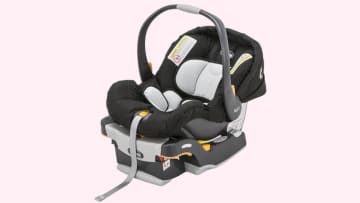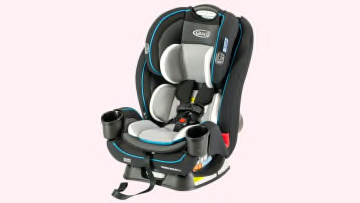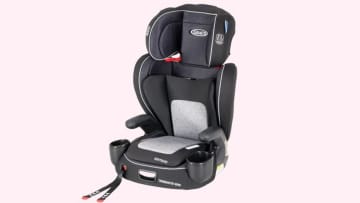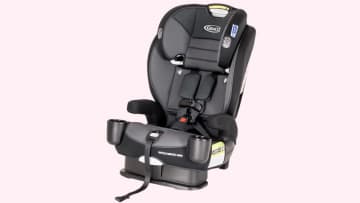Car Seats
Best Car Seats
Car Seat Buying Guide
Choose the Right Car Seat for Your Child
Our comprehensive guide will help you find the appropriate child seat for your little one's age and size. We'll also walk through when you'll need to move up to the next one—and how to double-check that you’re installing your car seat correctly.
Photo: Stephen Yang
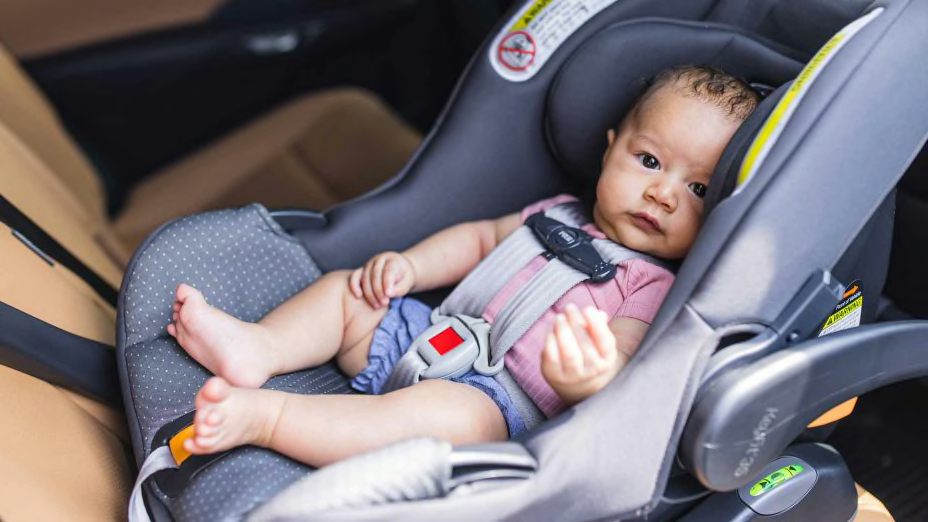
Top Car Seats Questions
How long will my child need a car seat?
You’ll need a child car seat from the moment you take your baby home from the hospital until he or she grows enough to properly fit into an adult seat belt, typically around age 10 or later.
CR’s Recommended Car Seat Use for Children Under the Age of 12
| Age (YEARS) |
Infant Rear-Facing |
Harnessed Rear-Facing |
Harnessed Forward-Facing |
Booster Seat |
|---|---|---|---|---|
| 0 | Recommended | Transitional | ||
| 1 | Transitional | Recommended | ||
| 2 | Transitional | Recommended | ||
| 3 | Transitional | Recommended | ||
| 4 | Recommended | Transitional | ||
| 5 | Recommended | Transitional | ||
| 6 | Transitional | Recommended | ||
| 7 | Transitional | Recommended | ||
| 8 | Transitional | Recommended | ||
| 9 | Transitional | Recommended | ||
| 10 | Transitional | |||
| 11 | Transitional |
- Recommended Use Period
- Transition Periods (Safe to use depending on the seat's limits and your child's height and weight.)
Which type of child car seat do I need?
As your child grows, you’ll need to transition from one car seat type to another. We’ll explain the different types to help you zero in on the right one for your needs.
-
Infant Car Seats
Price $70 to $550Orientation Rear-facing onlyWhat to Know This is the first seat purchased by most new parents. It has a removable carrier that connects to a base installed in the car. Most kids will probably grow too tall before they get too heavy for these car seats. A child is too tall when the crown of his head is less than 1 inch from the top of the car seat’s carrier shell or when he or she exceeds the height limits of the seat.pros & consInfant Car Seat Ratings- This car seat provides the best fit for newborns and smaller babies and can be used for children from 4 to 35 pounds (depending on the model).
- The convenience of the carrier.
- Many infant car seats can be paired with a compatible stroller for seamless transitions to and from the car.
-
Convertible Car Seats
Price $60 to $650Orientation Rear- and forward-facingWhat to Know The next step after outgrowing an infant seat is a convertible seat, which CR recommends should be purchased no later than your child’s first birthday. The harness system, similar to an infant car seat’s, has a higher rear-facing weight limit. In states that require rear-facing until age 2, switching to a convertible (or all-in-one) seat is usually a necessity. This means kids can ride rear-facing longer, which CR and the American Academy of Pediatrics recommend as the safest option. These seats can be used rear-facing up to 40 or 50 pounds (depending on the seat).pros & cons- Allows for your child to stay rear-facing longer, which is safer than an early transition to forward-facing.
- For use with an infant, this type doesn't provide the convenience of a detachable carrier.
-
Harnessed Car Seats
Price $100 to $450Orientation Rear-facing, forward-facing, and boosterWhat to Know These provide great value by taking a child from birth to booster seat. They’re a tempting money-saver, but they don’t offer the convenience and newborn fit of an infant seat. They can accommodate children from 4 to 50 pounds rear-facing, and kids from 20 to 65 pounds forward-facing using the seats harness. Additionally, all-in-ones can be used as a booster seat for kids up to 120 pounds once they meet the requirements for booster use.pros & consHarnessed Car Seat Ratings- They could be an alternative to purchasing multiple seats as a child grows for a caregiver who transports a child less often.
- All-in-one car seats are often large and heavy, lack the convenience of a detachable carrier, and might not fit smaller babies (or smaller vehicles) well.
-
Booster Seats
Price $14 to $280Orientation Forward-facing onlyWhat to Know When your child outgrows the weight or height limit of a forward-facing seat’s harness, it’s time for a booster that uses the car’s own seat belt. Boosters raise a child up in the car so that the seat belt fits correctly—over the sternum and the center of the collarbone (not the neck) and low across the upper thighs (rather than the abdomen). Many states have booster laws, some of which require children as old as 9 years and as heavy as 80 pounds to use a booster. They come in two main styles, high-back and backless.pros & consBooster Seat Ratings- Although backless versions are portable and easy to install, we recommend high-back models because they better position the vehicle seat belt, provide some side-impact protection, and are more comfortable for children to lay their heads against.
-
Toddler-Booster Seats
Price $60 to $330Orientation Forward-facing onlyWhat to Know These can be used only by children who are at the appropriate weight, age, and height limits to sit facing forward. Designed to be forward-facing only, these have a harness (for use up to a certain height and weight), and then transition to a booster, removing the harness. They’re for children weighing between 20 and 90 pounds harnessed, and 30 to 120 pounds in booster mode.pros & cons- Toddler boosters are a less expensive alternative to convertible seats (if your child meets the forward-facing age and weight requirements), and they offer a safe option for an older child not yet ready for a booster seat.
How much should I spend on a car seat?
Spending a lot of money doesn’t necessarily mean you’ll get the best car seat. Many midpriced models work as well as or better than pricier ones. An expensive model may give you more features for ease of installation or use, but paying more does not guarantee a safer seat.
What else do I need to keep in mind as I shop?
Know your child, and study up on your car.
Get used to keeping track of your child’s height and weight, which (along with age) can determine seat type and when it’s time to move up to the next level. Note: Any behavioral or health issues will also affect your choice.
Check the child-safety sections of your vehicle owner’s manual, and research relevant features such as belts, lower anchors, top tethers, and head restraints. For more information on which cars work best with child seats, see the Driving With Kids or Child Safety sections of our vehicle road-test reports and our Rear Seat Safety and Child Safety scores, which includes car seat fit and booster fit, on our vehicle model pages.
Is it okay to shop for a car seat online?
In the past, we recommended shopping in person; some retailers would even let you test-install a seat in your car, which was great because we’ve found that cushion angle or seat belt placement can make a car and child seat incompatible.
But with far fewer options for shopping in the store, there are some factors to keep in mind when ordering online. For one, read up on the return policy before you purchase. And leave yourself time to try the seat in your car, and return and replace it with another seat if it doesn’t work. In other words, don’t wait until the last minute.
Favor trusted retailers—or order straight from the manufacturer. Large chains such as Target and Walmart offer a limited range of products in stores and a wider selection online. Online retailers such as Albee Baby and Amazon offer an even larger selection of seat brands and models. Many retailers offer free shipping on car seats. If you order a seat from a third-party retailer, even from a trusted marketplace like Amazon or Walmart, use our tips to make sure your car seat meets safety regulations and is good to use.
How will I know when it’s time to upgrade my child to the next seat?
Even seasoned parents may be fuzzy on the right seat type and when it’s time for a change. Here are a few guidelines to keep in mind.
• Keep your baby rear-facing until at least 2 years old, or until they exceed the rear-facing height or weight limit of their seat. CR recommends moving your child to a rear-facing convertible no later than their first birthday for added head protection.
• Until your child outgrows the harness height or weight limit, stick with a forward-facing harness.
• Your child needs a booster seat until they are 57 inches tall, between 8 and 12 years old, and fits the vehicle belts correctly.
• You should replace a seat that’s damaged in any way or that has been in a moderate to severe accident (use the National Highway Traffic Safety Administration’s checklist).
• Even after your child is ready to use just the vehicle belt alone, they should ride in the backseat until age 13.
• Seats that have not been in a crash can be reused, but they do expire. Some have a printed date—usually on the manufacturer’s label or molded into the seat, which always includes a production date. Others will expire in a certain number of years, so it’s up to you to check the child seat manual and do the math.
How do I know I’m installing the child car seat correctly?
According to National Digital Check Form, used by car seat technicians in the field, there is a misuse rate of nearly 63 percent (as of September 2023) when it comes to car seat installations. Yes, you read that right—the majority of child seats are not installed correctly.
When installing, be sure to follow the vehicle owner’s manual and seat instructions, and consider having your installation checked by a Child Passenger Safety Technician at a car seat checkup event.
Here’s how to make sure it’s installed properly.
Right seat: Check the seat’s height and weight limits. Age is also an important factor because it is reflective of your child’s skeletal development.
Seat tight: Once installed, the seat shouldn’t move more than 1 inch side to side or front to back. Don’t get discouraged—this can be tricky.
Harness height: In a rear-facing installation, the harness straps are at or below your baby’s shoulders. For forward-facing, harness straps should be at or above your child’s shoulders. The chest clip should always be at armpit level.
Harness tight: If your child is secured properly, you shouldn’t be able to pinch any fabric on the straps at the child’s shoulders.
Final check: Recline right and tether tight. Check the recline angle for rear-facing seats (most have an indicator) to avoid allowing the child’s head to fall forward and obstruct breathing.
For forward-facing seats installed with either lower anchors or the vehicle’s seat belt, always attach and tighten the top tether to help prevent forward movement, which could cause head injury.
We also have a visual guide on how to avoid common car seat installation mistakes.
















